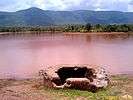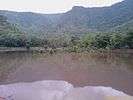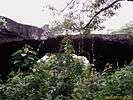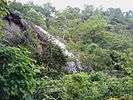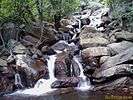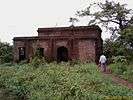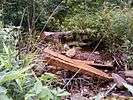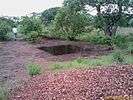Nru-siṃha-nāth (pronounced ନୃ-ସିଂହ-ନାଥ in Oriya, ନର-ସିଂହ-ନାଥ୍ in local Kosli Language, नृसिंहनाथ in Hindi) is small village, temple and tourist spot located in Bargarh District of Western Orissa. Nru-siṃha-nāth is god "Narasimha" , one avatar of the dashavatar of god Vishnu in the incarnation of "BiDāla Nrusimha" or "MarjāraKeshari" is the prime god of this 14th century temple, built by King Baijala Deba. It is a very famous place in Orissa people from different states comes to visit narsighnath. It is 5 km away from paikmal. The environment and the weather is very nice. we can see there temples, priest ,monkeys, shops, people from different places for picnic.
Significance
The word Narasimha means half-man and half-lion Nātha means owner or Lord. The half-woman-half-lion is called Sphinx in Egypt and Manticore in Persia. In Hindu culture, Nrusimha or Nara-Sinha is one of the 10 Avataras or Incarnations of god Vishnu.
Terms Used in this article:
Jharan - Spring, Dangar - Hill, Māhāpru - God/ Lord (male), Devi - Deity (Female), Vidāla/ Mārjāra - Cat, Musā/ Mushika - Rat, GuDi/ Mandir - Temple, Khol - Cave, Maduā/ Mado - Cave/ Temporary Shelter made up of cut tree branches, leaves, or other natural and locally available material, MeLā - Large gathering of people to celebrate festival, Jhānkar - Priest of temple
Waterfalls
Chāl-dhār
This is the first waterfall near the temple. There is a platform for the visitors to take bath. The word Chāl means a "bamboo strip woven mat". During Nrusingh Chaturdashi festival, the bathing platform is extended using such mats, hence the waterfall name became Chāl-dhār.
Kapil-dhār
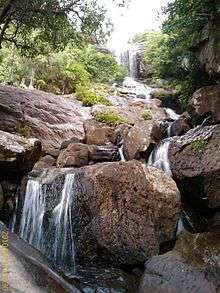
Kapildhār waterfall
This is the tallest and major water-fall in this mountain, located at about 400 meter altitude, above sea-level. There is a 4 kilometer motorable road to this from the Temple.
Traditional stories and religious beliefs
About the appearance of the god
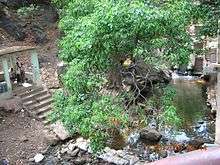
Gokund Ghat
As per the epic Bidāla Nrusingha [1]
Image gallery
| Some photographs of Gandhamardan Hills |
|---|
| Gandhamardan Hills on backdrop of a Checkdam. |
| Gandhamardan Hills from another dam. |
| Bhimmado - the natural cave atop the hills |
| Kapildhar waterfall - side view |
| Kapildhar waterfall - front view |
| Unnamed waterfall on the hills |
| Ancient house on the hilltop |
| Southern side of Gandhamardan Range |
| Gandhamardan Bauxite Test pit on hill top |
| North Eastern View of the mountains |
| Gokund Ghaat or Paapa Nashini Ghat |
|
References
- http://www.orissa.gov.in/e-magazine/Orissareview/june2006/engpdf/150-157.pdf
- Advances in Limnology By Mishra - page no 223-224
- Introducing Orissa By Balaram Mohanty - page no 102
- History of library development By B. D. Panda - page no.59
- Conservation and Utilization of Medicinal and Aromatic Plants By S Sahoo - page no. 22
- Yogadas : Nrusimha Charita (Edited by N.Pruseth),Padampur: Dora Art Press
- The environmentalism of the poor: a study of ecological conflicts and valuation By Juan Martinez-Alier -page no. 261
- Tourism directory, Orissa by Orissa (India). Dept. of Tourism & Cultural Affairs - page no. 69
- Land and people of Indian states and union territories: in 36 volumes. Orissa By S. C. Bhatt, Gopal K. Bhargava - page no. 418, 419
- Orissa Govt. e-magazine - Orissa Review - July 2003 - page no. 103, 104, 105
- Encyclopaedia of tourism resources in India, Volume 2 By Manohar Sajnani Page no. 280
- India, a reference annual - by Ministry of Information and Broadcasting. Publications Division. India. page no. 739
External links

